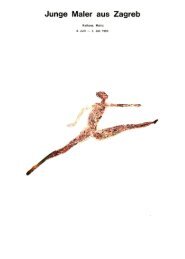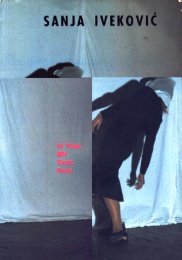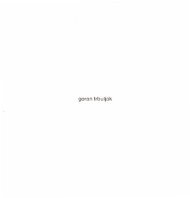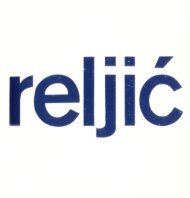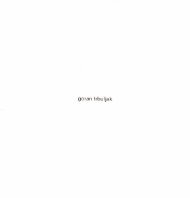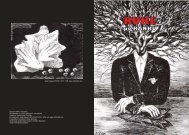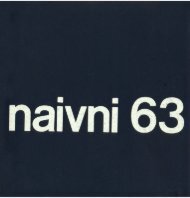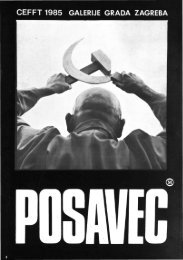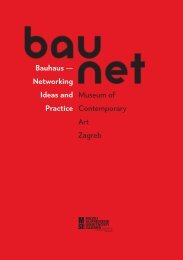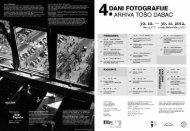Chen Zhen - Muzej suvremene umjetnosti Zagreb
Chen Zhen - Muzej suvremene umjetnosti Zagreb
Chen Zhen - Muzej suvremene umjetnosti Zagreb
You also want an ePaper? Increase the reach of your titles
YUMPU automatically turns print PDFs into web optimized ePapers that Google loves.
<strong>Chen</strong> <strong>Zhen</strong> interviewedby Jerome SansSonorous Silence ... J. S. Your work hasalways been about thetensions and antagonism between man and nature. Now that nature has become "conceptual",reduced to afew rare signs in the city, this theme is more relevant than ever.C. Z. When we talk about sptrttualtty, we think too reađily of religion. But nature,likeman, has an undeniable spiritual force. This force is not abstract. it is substantivematter which influences our body's emotional and immune systems. The Germanphilosopher Meister Eckhart said that "Man's etemal body is imagination". Therefore"spirit", man's spiritual force, is the soul of art. I have been active in this sphere formany years now. Already, in 1990. as I said in an interview with you, I was centringmy enquiries on the relation between man, nature and consumer society. Ten yearslater, in spite of the broadening of my territories of concern, this dimension remainspresent. If, at the time, I introduced nature into my works, it was as if to confront itwith our artificial and materialistic world. Over the years, this concern with naturehas broadened out. I also consider it as a therapeutic power, as an irrational balaneingfactor, and for its spiritual and critical dimension. I try to introduce the rnythicalsynergy that nature has for my mind and my body. I bcrrow this natural force for mywork. This perpetual desire to put nature at the centre of my ideas allows me to maintainmy engagement. In 1995, when I covered the space of Galerie Ghislaine Hussenatin Paris with earth, plus a number of objects, the idea was to create a place of purification.In 1997, the Eu Dao/Eu Dao or Upside-down Buddha-Arrival at Good Fortuneproject, presented at the CCAin Kitakyushu, Japan, questioned the relation betweenBuddhist tradition, nature and the proliferation of Asian artefacts with ever shorterlife spans. In 1998, my design for the Paris Rive Gauche development, s'ancrer dansl'eau, la terre et evoluer dans l'espace-temps ("Ground yourself in water and earth,move in space-time"), put the emphasis on rnan's position in the megacities and onthe relations between production cycles and natural cycles. In 1999, Fuir a i'anqtatse(Sneak Away] in Breda, Holland, ironised about the invitation to make art on a 350-hectare, $0 metre-deep public dump. With the Jardin tavoir at the Centre d' ArtCimaise et Portique, Albi, water is used as a "healer" in order to freshen up not onlyeveryday objects but also the space itself. All these projects, done in different timesand places.Hnk together in the continuation of consciousness and confidence. This iswhat I call a "fragmented slowing-down", a process that accumulates different experiencesof the same subject in time and space. A process that enables me to have a certainnumber of works in progress that I can go back to at any moment. Like a series ofcomputer folders that you can reactivate, update and download.J. S. To me you seem to use the word "between" (entre] strategically, so as not to have tofix your target and to leave enough space/or thought.C. Z. Absolutely. It's a matter of attitude, of ways of looking at the world. For me theworld is not an object. which is unlike the Greeks, who were the first to grasp theobject, to determine substance as an object. Chinese thought oscillates "between"objects and elements. A kind of "non-object" and "non-place" which, according toFrancois Jullien's interpretation, describes "the ephemerality and uninterrupted48



